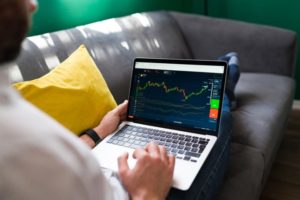
Image Source: tonodiaz on Freepik
In this digital age, there are numerous ways to earn money by working from the comfort of your home as advanced technology allows us to explore a lot of employment opportunities online. Be it a remote job or being your own boss by becoming a full-time trader, those who are willing to work hard can surely attain financial freedom. Forex trading has emerged as a popular and rewarding career option that you can also consider as a side hustle. In order to trade forex with ease, you have to open a trading account with a broker and join an online trading platform.
One well-known trading platform that has won the trust of millions of forex traders from all parts of the world is the MetaTrader 4. MT4 is still the most preferred platform among forex traders and it is an easy-to-use trading software even for an average beginner. You too can login to MT4 and trade in a demo account to get the hang of the platform. Then, you can choose the type of trading account you wish to trade. Forex Brokers provide several options to meet the requirements of different types of traders and you need to choose the most suitable trading account for a seamless trading experience.
If you are not sure about the characteristics of different types of accounts, then this beginner’s guide to online forex trading accounts can surely help you pick the best trading account for yourself.
Online Trading Accounts
There are different types of trading accounts that you can open for online forex trading. The number of options you get will depend on the broker you choose. Almost all brokers provide a free demo account that you can use to try the platform and test your strategy without any risk. Demo accounts are ideal for learning as you will get to experience trading in real-time market conditions by trading with virtual funds.
The forex accounts that you will be using to trade with real funds are called live trading accounts and let’s have a look at the most commonly used account types.
- Mini Accounts
Mini accounts are ideal for those who want to trade in the live market but at the same time, they want to take minimal risk by reducing the position size. The size of your trade position is calculated as the number of lots you buy or sell while placing an order. In forex, you can choose to trade with standard, mini or micro lot sizes. Choosing a micro lot means that you will be trading with 1000 units of currency, which is also the smallest lot size. The standard is the largest lot size with 1,00,000 units of currency. A mini lot falls in the middle of the two with 10,000 units of currency.
When you trade on mini accounts, you can conveniently place your orders in mini lots. Since the position size will be smaller, you can easily trade with a smaller amount of trading capital. You can understand the difference between a mini and standard account better by considering the pip value which expresses the price movements that happen in a currency. When you are trading with a standard lot, one pip of a currency pair with USD as the base currency will be $10.
But if the same trade is placed in lots, one pip of the currency pair will be just $1, which means a mini lot is 1/10th of the standard lot. This means that the mini account allows you to trade with a low minimum deposit and this can be perfect for new traders to start small. Even experienced traders use mini-accounts to test new strategies while limiting their exposure to market risk. This way, they get to evaluate the performance of a new strategy before risking a bigger amount.
- Standard Accounts
Just as the name suggests, a standard account is used to trade with the default lot size. You will need a decent amount of capital for trading with standard lot size which is equivalent to trading with 10 mini lots. Standard forex account is also the most commonly used account type as this trade size is ideal for making enough profits from trading. The minimum capital requirement for a standard account will be different depending on the broker you choose.
When you are planning to open a standard trading account, you need to consider a lot of things before selecting your broker. You must start by opening a demo account to test the functionality of the trading platform being offered along with the trading conditions that you will get with the broker. A cost-effective broker providing fast execution of trades with tight spreads and low commissions is essential to save money on trading costs while also avoiding slippage.
You should sign up with a regulated broker to ensure a secure trading experience and also check the other types of accounts they offer. Even in the case of standard accounts, you may see different options to choose from. These days many brokers offer commission-free trading accounts and premium accounts for professional traders. You will also see accounts with a low minimum deposit requirement which is suitable for retail traders. So, select the one that fits your bill.
- Managed Forex Accounts
The third type of account that you can consider for forex trading is a managed trading account. In a managed account, you will not be trading yourself instead you will be doing what an investor does but the process of making profits will be different from what happens in a traditional investment. There are two types of managed accounts where you can invest your funds. These are known as PAMM and MAM accounts and they are very similar in functioning but there are also some differences.
In forex PAMM accounts, the money from different investors will be pooled together and the PAMM account manager will be taking all trading decisions on your behalf. PAMM stands for Percentage Allocation Management Module as the profits and losses are shared among investors based on the percentage of money that they have invested with a PAMM account manager. You won’t be able to enter or exit trades on your own and you won’t get much control over the trading process.
But MAM accounts are different as they allow you to set some conditions for managing the risk yourself. The trading activities will still be carried out by the MAM account managers but you can decide the amount of risk you want to take in trading by specifying the leverage. MAM is the abbreviation for Multi Account Manager as the account manager is simply managing multiple accounts. This type of account is more suitable for experienced investors who want to manage the risk themselves.
Conclusion
In the end, trading has become way easier with the different types of forex accounts that are offered by forex brokers. Those who want to earn by trading themselves can open a mini or standard account based on the lot size they prefer. Those who want to earn passive income by investing can sign up for MAM/PAMM accounts to maximise the profits with minimal effort. However, diversification is essential to minimise the risk.



